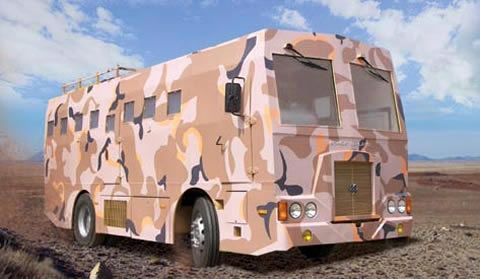Several teams headed by Indian largest vehicle manufacturers Tata Motors, Ashok Leyland and Mahindra and Mahindra are introducing Mine Protected Vehicle in anticipation of Indian Ministry of Defense procurement of hundreds of new mine protected vehicles. The growing market for such vehicles is evolving around the military and security forces need to support growing tension in the North East, North West, and Anti-Naxal internal security operations.
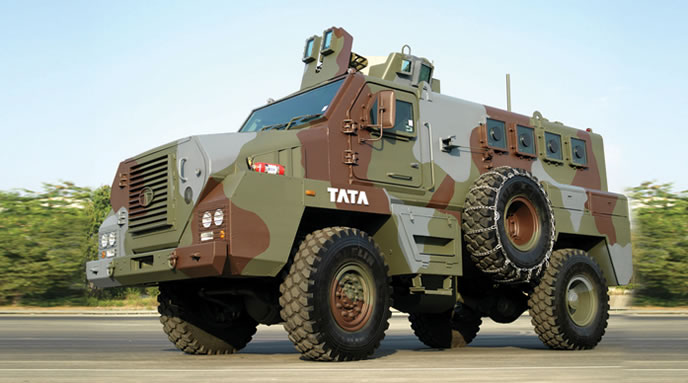
Defence Land Systems India, a joint venture between the Indian company Mahindra and Mahindra and global defense manufacturer BAE Systems, introduced the new Mine Protected Vehicle India (MPV-I). The company, a Joint Venture between BAE Systems and Mahindra has based its design on BAE System’s RG family of vehicles, which relates back to the successful family of mine protected vehicles from South Africa. The 6×6 MPV-I is based on BAE Systems’ three decades of protection experience, that resulted in the highly successful RG 31, which has a proven track record and is currently in service with US, Canadian, UAE and a number of other forces including the UN. The MPV-I has been developed for the counter insurgency and anti-Naxal operations of Indian armed and paramilitary forces. The vehicle was recently tested and survived a blast in which 14 kg of explosives were used. The MPV-I can accommodate 18 personnel, capable of transporting a complete operational team of army or police forces involved in anti-terrorist and anti-Naxal operations.
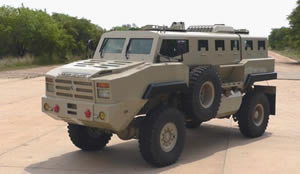
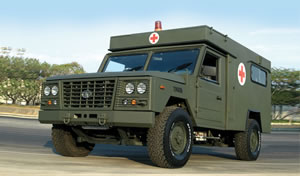
“With enhanced protection technologies, the new vehicle provides the highest levels of crew protection available in India today.” Said Brig Khutub Hai, Mahindra Defence Systems (MDS) chief executive. “The MPV-I will be our first new product offering from the joint venture company.” The MPV-I will be manufactured at the Defense Land Systems, India plant at Prithla near Faridabad. “The high power to weight ratio and very high torque makes the vehicle suitable for Indian terrain, especially the mountainous region of Jammu and Kashmir and the rough topography of the Naxal dominated areas.” He added. Ashok Leyland has also introduced a version of the Mine Protected Vehicle, based on its Stallion 4×4 armored car. For this development Ashok Leyland has teamed with the South African company Paramount Group. This multipurpose, all-terrain vehicle offers high mobility, high protection and multi-mission capabilities, to Troop Carriers, Armored Personnel Carriers, Command Vehicles, Border Patrols, Riot Control, Internal Security and Counter Terrorism. The MPV-I has a power-to-weight ratio of 13.5 kW/Ton, accelerating the vehicle to a maximum road speed of 90 Km/hr, and a road range exceeding 1000 kilometers without refueling. The basic configuration offers STANAG level 1 protection (7.62 SLR Ball, 5.56 INSAS and 7.62 AK-47/56 Rifle) with mine blast protection exceeding STANAG 4569 level 4, safely absorbing blasts of 14 kg TNT under hull and triple anti tank mine protection – 21 kg TNT under wheels. Extra features includes add-on armor kits, run flat tires inserts, roof mounted air conditioners, radios and intercom systems, 8 ton winch, GPS Navigation, roof mounted weapon stations and gun mounts, gun ports. “Our entry into armored vehicles is in answer to an ever-increasing demand from the Armed Forces for well-engineered, high-mobility, high protection, tactical vehicles that can be used in counter-insurgency and counter-terrorist operations,” said Mr. Vinod K Dasari, Chief Operating Officer and Whole Time Director, Ashok Leyland.
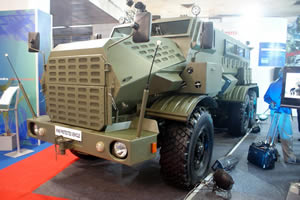
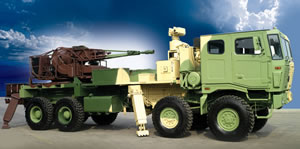
Tata Motor is also entering the MPV arena – the new Mine Protected Vehicle from TATA is based on a modular design, implementing a V shaped hull for blast protection. The vehicle is designed for counter-insurgency operations. In addition to mine-and blast protection, the hull is protected against small arms to a NIJ Level 3BP. The roof mounted turret mounts a light or heavy machine gun, covering uninterrupted 360 degrees, two roof hatches to troops for observation and counterfire. In addition, 9 firing ports offer firing from within the vehicle. The air conditioned cabin can be configured to accommodate 8 or 12 soldiers, or to be tailored for mission-specific roles such as command, or medical evacuation. The vehicle is powered by a 245 PS diesel engine, and is capable of a top speed of 100 kmh, negotiating gradient of 60%. The vehicle has 860 mm ground clearance and can ford of 1000 mm water obstacles without preparation. Besides the Army, Tata Motors will also offer the vehicle to paramilitary and police forces. According to P.M. Telang, Managing Director (India Operations) of Tata Motors, TATA’s aim is to ‘participate in the entire defense value chain’, among this, the manufacturing of tactical vehicles and equipment, in addition to upgrades and life extension of systems. In addition to the MPV, Tata is also offering a 8×8 wheeled Weapon Platform, designed to accommodate heavy loads such as air defense systems, rockets or artillery guns, surveillance equipment, communications shelters etc. With ground clearance of 400 mm, compensating bogey suspension and wide wheel tracks, the truck offers impressive cross country mobility, including fordability of 1.2 m water obstacles and trench crossing ability of 2 meters. The tiltable cabin is compatible with add-on armor and NBC protection. The vehicle is powered by a 380/420 PS engine. Another military vehicle unveiled by Tata is the Light Specialist Vehicle (LSV), configurable for reconnaissance missions, counter-insurgency operations or as an ambulance.
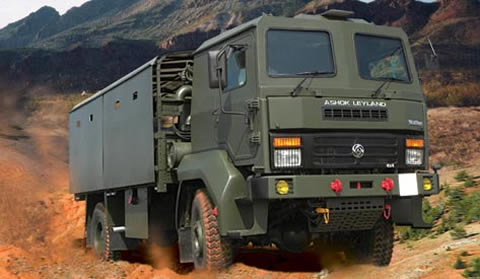
Ashok Leyland is showing three new armored vehicles, all based on the proven Stallion platform – the 4×4 wheeled Mine Protected Vehicle, a Multi-Purpose Armored Carrier (MPAC) and an armored bus. MPAC uses the Stallion 4×4 platform upgraded with an armored sleeper cab and a protected load body for cargo into a versatile platform, configurable into a troop carrier, logistics support vehicle, riot control, communication vehicles, command post or ambulance.. The cab and load body offers protection against AK-47 Kalashnikov 7.62x 39 mm on both the sleeper cab and load body. Ashok Leyland’s new armored bus is also based on the Stallion. It was developed in response to the Indian Army’s requirement to transport army personnel and their families throughout insurgency infected areas. The armored bus is designed to offer all round protection against 7.62 x 51 ball (SLR), 5.56 mm INSAS and AK – 47/56 projectiles fired from a distance of 10m. The design features a unique approach to blast protection of a large cabin – the roof-hung floor. The seats in the bus are mounted on a floor which is hung from the roof, mitigating the blast effect, caused by mine or IED explosion under the vehicle. The floor is also covered by spall liners offering additional protection from penetrating fragments.
